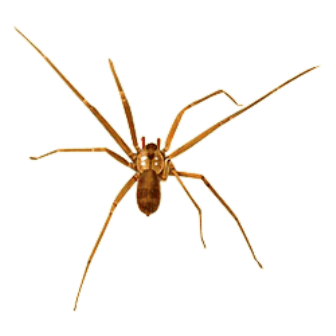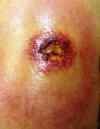Discover Florida Nature
It's time to explore the natural Florida


|
|
|
|
|
 Recluse
spiders are also known as violin, fiddleback, or brown spiders. These
venomous spiders are found worldwide, most commonly in the tropics, with
some species reaching temperate latitudes. No species of recluse spiders
are native to Florida, but three species have have established
populations in scattered locations throughout the state. The brown
recluse spider, is frequently reported in Florida as a cause of necrotic
lesions in humans. For example, in the year 2000 alone the Florida
Poison Control Network had recorded nearly 300 alleged cases of brown
recluse bites in the state. The brown recluse has been found in Alachua,
Bay, Duval, Jefferson and Leon counties, with most counties in central
Florida having reports of alleged brown recluse spider bites. Many
wounds are erroneously attributed to this spider, but there are multiple
other causes of necrotic wounds. Recluse
spiders are also known as violin, fiddleback, or brown spiders. These
venomous spiders are found worldwide, most commonly in the tropics, with
some species reaching temperate latitudes. No species of recluse spiders
are native to Florida, but three species have have established
populations in scattered locations throughout the state. The brown
recluse spider, is frequently reported in Florida as a cause of necrotic
lesions in humans. For example, in the year 2000 alone the Florida
Poison Control Network had recorded nearly 300 alleged cases of brown
recluse bites in the state. The brown recluse has been found in Alachua,
Bay, Duval, Jefferson and Leon counties, with most counties in central
Florida having reports of alleged brown recluse spider bites. Many
wounds are erroneously attributed to this spider, but there are multiple
other causes of necrotic wounds. Recluse spiders are medium-sized (6-12 mm body length), with uniformly-colored abdomens that can vary from a tan to dark brown. The males and females are about the same size. The body, including the legs, is a little wider than a quarter dollar coin. In many species there is a characteristic darkened violin-shaped pattern which occurs on the front half of the head region. However, other unrelated spiders may have a pattern which can easily be mistaken for the violin. A more useful method of determining recluse spiders is by using the eye pattern. Most spiders have eight eyes arranged in two rows of four, but recluse spiders have six eyes arranged in three pairs (dyads), with one anterior dyad and a lateral dyad on each side. Some related spiders, particularly spitting spiders (which have a unique domed head region), have a similar eye pattern, but these are otherwise different. Recluse spiders make a protective silken retreat, but they are usually hunters that leave the web in search of prey. They can be abundant in human structures. The Brown Recluse inhabit the south and south-central states from Georgia through Texas and north to Wisconsin. A few years ago it was common belief that there were no brown recluse spider populations in neither California or Florida. Unfortunately this is changing, recent evidence suggest that the brown recluse spider is expanding across the US and there may already be a thriving population in both Florida and California.  Brown
Recluse spiders feed on cockroaches and other insects. They do not spin
webs to catch prey but instead hunt for their prey or wait until an
insect comes in close proximity to them. Mobile prey like houseflies and
relatively harmless prey are held down with the initial bite while the
venom does its work. With prey that might be more harmful to the spider,
such as other spiders or ants, they will lunge and bite the prey in a
vulnerable area and immediately back away while the venom acts to
quickly paralyze them. The spider then moves in to feed. The same venom
that acts to liquefy an insect's innards for consumption also causes the
"flesh rotting" appearances in human wounds. The Chilean Recluse species
from South America has been found in the suburbs of Los Angeles, and in
Polk County, Florida. The Chilean Recluse is believed to be the most
toxic Recluse spider and is implicated in a number of deaths in South
America. Brown
Recluse spiders feed on cockroaches and other insects. They do not spin
webs to catch prey but instead hunt for their prey or wait until an
insect comes in close proximity to them. Mobile prey like houseflies and
relatively harmless prey are held down with the initial bite while the
venom does its work. With prey that might be more harmful to the spider,
such as other spiders or ants, they will lunge and bite the prey in a
vulnerable area and immediately back away while the venom acts to
quickly paralyze them. The spider then moves in to feed. The same venom
that acts to liquefy an insect's innards for consumption also causes the
"flesh rotting" appearances in human wounds. The Chilean Recluse species
from South America has been found in the suburbs of Los Angeles, and in
Polk County, Florida. The Chilean Recluse is believed to be the most
toxic Recluse spider and is implicated in a number of deaths in South
America. Brown recluse spiders usually bite only when they become trapped next to the victim's skin. Bites occur either when sleeping humans roll onto the spider or put on clothes into which the spider has crawled. Typically bites occur under clothing, mostly on the thigh, upper arm, or lateral torso, less often on the neck.  Reactions
to a bite vary from no noteworthy symptoms to severe necrosis or
systemic effects, including death or loss of limbs. Discomfort may be
felt immediately after the bite, or several hours may pass before any
local reaction to the bite occurs. The first is the amount of venom
injected by the spider. Like some venomous snakes, spiders are known to
sometimes give "dry" bites, with little or no venom injected. The second
variable is the sensitivity of the victim. Some people are simply more
prone to have a severe reaction in instances where another person might
only have a slight reaction. Typical symptoms are as follows: Symptoms
start two to six hours after the bite. Blisters frequently appear at the
bite site, accompanied by severe pain and pronounced swelling. Reactions
to a bite vary from no noteworthy symptoms to severe necrosis or
systemic effects, including death or loss of limbs. Discomfort may be
felt immediately after the bite, or several hours may pass before any
local reaction to the bite occurs. The first is the amount of venom
injected by the spider. Like some venomous snakes, spiders are known to
sometimes give "dry" bites, with little or no venom injected. The second
variable is the sensitivity of the victim. Some people are simply more
prone to have a severe reaction in instances where another person might
only have a slight reaction. Typical symptoms are as follows: Symptoms
start two to six hours after the bite. Blisters frequently appear at the
bite site, accompanied by severe pain and pronounced swelling.
 A
common expression is the formation of a reddish blister, surrounded by a
bluish area, with a narrow whitish separation between the red and blue,
giving a "bull's-eye" pattern. By 12 to 24 hours, it is usually apparent
if a recluse spider wound is going to become necrotic because it turns
purple in color; if necrotic symptoms do not express by 48 to 96 hours,
then they will not develop. If the skin turns purple, it will then turn
black as cells die. Eventually the necrotic core falls away, leaving a
deep pit that gradually fills with scar tissue. A
common expression is the formation of a reddish blister, surrounded by a
bluish area, with a narrow whitish separation between the red and blue,
giving a "bull's-eye" pattern. By 12 to 24 hours, it is usually apparent
if a recluse spider wound is going to become necrotic because it turns
purple in color; if necrotic symptoms do not express by 48 to 96 hours,
then they will not develop. If the skin turns purple, it will then turn
black as cells die. Eventually the necrotic core falls away, leaving a
deep pit that gradually fills with scar tissue.
|
|
|
Advertise | Privacy Statement | Dog Encyclopedia | Video |Contact | Alaska Nature |
|